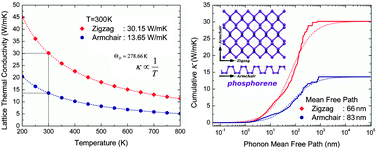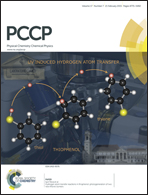Anisotropic intrinsic lattice thermal conductivity of phosphorene from first principles†
Abstract
Phosphorene, the single layer counterpart of black phosphorus, is a novel two-dimensional semiconductor with high carrier mobility and a large fundamental direct band gap, which has attracted tremendous interest recently. Its potential applications in nano-electronics and thermoelectrics call for fundamental study of the phonon transport. Here, we calculate the intrinsic lattice thermal conductivity of phosphorene by solving the phonon Boltzmann transport equation (BTE) based on first-principles calculations. The thermal conductivity of phosphorene at 300 K is 30.15 W m−1 K−1 (zigzag) and 13.65 W m−1 K−1 (armchair), showing an obvious anisotropy along different directions. The calculated thermal conductivity fits perfectly to the inverse relationship with temperature when the temperature is higher than Debye temperature (ΘD = 278.66 K). In comparison to graphene, the minor contribution around 5% of the ZA mode is responsible for the low thermal conductivity of phosphorene. In addition, the representative mean free path (MFP), a critical size for phonon transport, is also obtained.


 Please wait while we load your content...
Please wait while we load your content...